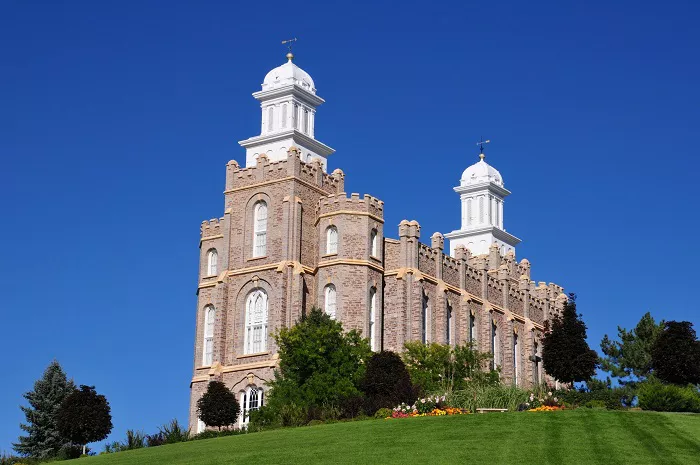Nestled in the heart of Cache Valley, the Logan Utah Temple stands as a beacon of spiritual devotion and architectural grandeur. As the second temple constructed in Utah and the fourth overall by The Church of Jesus Christ of Latter-day Saints, its rich history and enduring presence continue to inspire both church members and visitors alike. This article delves into the intricate tapestry of the temple’s conception, construction, architectural significance, and its profound impact on the community.
Historical Context and Conception
The announcement of the Logan Utah Temple came on October 6, 1876, by Church President Brigham Young during the Church’s general conference. Recognizing the growing needs of the Latter-day Saint community in northern Utah, Young envisioned a sacred edifice that would serve as a spiritual haven for the faithful. The chosen site, a nine-acre plot in Logan, was selected for its elevated position, offering a panoramic view of the valley and symbolizing a place closer to the heavens.
Groundbreaking and Construction Efforts
The groundbreaking ceremony took place on May 18, 1877, led by Elder Orson Pratt, with President John W. Young turning the first sod. Remarkably, at the time of this ceremony, the Church had not yet officially acquired the land, which was later purchased on April 24, 1878. The construction was a monumental community effort, with over 25,000 individuals contributing their labor, materials, and resources. Timber was sourced from Logan Canyon, while limestone and sandstone were quarried from nearby Green Canyon and Franklin, Idaho, respectively. Women in the community also played a pivotal role, handcrafting over 2,000 square yards of carpet for the temple’s interior.
Architectural Design and Symbolism
Designed by Truman O. Angell, the Church’s head architect, the Logan Utah Temple showcases a blend of Gothic Revival and French Renaissance architectural styles. Its castellated exterior, characterized by battlements and towers, mirrors the design of the Manti Utah Temple, reflecting a medieval fortress-like appearance that symbolizes spiritual strength and protection.
Exterior Features
The temple’s exterior is constructed from dark-colored siliceous limestone, a durable and compact stone. Buff-colored sandstone was utilized for intricate carvings and detailed work. Initially painted a pinkish hue to mask the dark stone, the paint was allowed to weather away in the early 1900s, revealing the natural beauty of the limestone. The structure features two prominent towers: the east tower, standing at 170 feet, and the west tower at 165 feet, each representing the Melchizedek and Aaronic priesthoods, respectively.
Interior Layout and Ornamentation
Originally, the temple’s interior boasted progressive-style ordinance rooms adorned with murals depicting stages of spiritual progression: the Creation, Garden, World, Terrestrial, and Celestial rooms. These murals served as visual aids during live-acted endowment ceremonies. However, during the extensive renovations in the 1970s, these rooms were replaced with stationary ordinance rooms equipped for motion-picture presentations, aligning with modern practices. Despite the changes, the temple retained its spiritual ambiance, with the Celestial Room featuring a grand crystal chandelier, symbolizing divine light and enlightenment.
Renovations and Modernization
Over the years, the Logan Utah Temple has undergone several renovations to preserve its structural integrity and accommodate the evolving needs of its patrons. In 1915, a significant renovation introduced electricity to the building. A fire in 1917 caused substantial damage to the southeast staircase, necessitating repairs costing approximately $40,000. The most extensive renovation occurred between 1976 and 1979, during which the interior was completely gutted and rebuilt, expanding the total floor area to 115,507 square feet. This renovation also introduced modern amenities such as updated heating, air conditioning, and elevator systems. The temple was rededicated on March 13, 1979, by President Spencer W. Kimball.
Cultural and Community Impact
Beyond its religious significance, the Logan Utah Temple has played a vital role in the community’s cultural and educational development. Shortly after its dedication, the temple housed the Logan Temple Association School, offering courses in various subjects while emphasizing spiritual teachings. Although the school ceased operations in 1912, its legacy underscores the temple’s commitment to holistic education. Additionally, the construction of the temple provided local workers with skills in masonry and carpentry, leading to the establishment of businesses that contributed to the region’s economic growth.
Visiting the Logan Utah Temple
Located at 175 North 300 East, Logan, Utah 84321-4720, the temple stands as a prominent landmark in the city. While access to the temple’s interior is reserved for Church members with a valid temple recommend, the beautifully landscaped grounds are open to the public, offering a serene environment for reflection and appreciation of the temple’s architectural splendor. Visitors can also explore the nearby Logan Tabernacle, located just two blocks away, which shares historical ties with the temple.
Conclusion
The Logan Utah Temple embodies the dedication, faith, and unity of the Latter-day Saint community in the late 19th century. Its enduring presence serves as a testament to the collective efforts of thousands who contributed to its construction and the generations that have maintained its sanctity. As both a spiritual sanctuary and architectural marvel, the temple continues to inspire reverence and admiration, standing as a symbol of unwavering faith and communal harmony.

